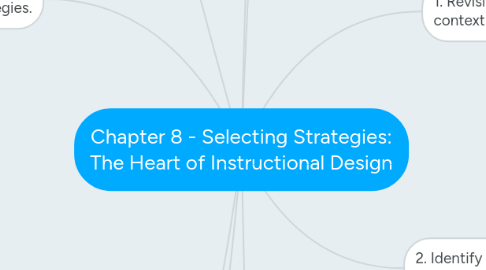
1. 5. Seek review and/or approval of the treatment, the aligned outcomes, assessments, strategies, and the technologies (Chapter 9).
2. 4. Select technologies to support the strategies identified (Chapter 9).
3. 3. Identify appropriate interactions and strategies.
3.1. all instruction involves one or more types of interaction - and it applies to all delivery modes
3.2. Learner to Content Interaction
3.2.1. Organizational strategies are used to guide the selection, sequencing, and presentation of instruction and strategies
3.2.2. Used to facilitate learner processing, coding, retrieval, use, and transfer of content
3.2.3. LOTS and HOTS
3.2.4. Traditional modes: discussions, drill-and-practice, games, simulations, experiments, discovery learning projects, problem solving, assessments
3.2.5. Provide access to content: physical or electronic versions of materials, live or recorded lectures, physical or projected images, etc.
3.3. Learner to Instructor/Facilitator Interaction
3.3.1. face-to-face settings make this easier
3.3.2. virtual environments must plan strategically to give opportunities
3.4. Learner to Context Interaction
3.4.1. be aware of environmental issues (poor lighting, heating, etc.)
3.5. Learner to Learner Interaction
3.5.1. interactions can be synchronous or asynchronous
3.5.2. give opportunities for learners to discuss and interact, making connections
3.6. Learner to Self Interaction
3.6.1. meta-cognitive self-reflection
3.7. Marzano's Nine Categories of Effective Strategies
3.7.1. Identify similarities and differences
3.7.2. Summarize and take notes
3.7.3. Reinforce effort and provide recognition
3.7.4. Homework and practice
3.7.5. Non-linguistic representations
3.7.6. Cooperative learning
3.7.7. Set objectives and provide feedback
3.7.8. Generate and test hypotheses
3.7.9. Cues, questions, and advance organizers
4. Strategy Frameworks:
4.1. Gagne's Nine Events of Instruction (instructivist approach)
4.2. BSCS Five Es Instructional Model (constructivist approach)
4.3. Connectivist Learning Environments (connectivist approach)
4.4. Keller's ARCS Motivation Model (use with any approach)
4.5. Scenario Planning Guidelines (use with any approach)
5. 2. Identify assumptions and pedagogical approaches.
5.1. What is appropriate?
5.2. What assumptions about learning are reflected in the defined outcomes?
5.3. OUTCOMES reflect ASSUMPTIONS that lead to PEDAGOGICAL APPROACHES supported by INTERACTIONS accomplished through INSTRUCTIONAL STRATEGIES
5.4. Ask yourself: Does each outcome require its own activity or can I optimize instruction by addressing several outcomes in one activity?
6. 1. Revisit and refine the learning context design.
6.1. learning context and strategies will affect each other
6.2. learning context: time, place, dispersion of instruction, delivery mode, learner group
6.2.1. Does the learning experience work for these aspects?
6.3. Things to consider:
6.3.1. human and non-human resources and funds
6.3.2. development time vs. established deadlines
6.3.3. implementation time
6.3.4. learner familiarity with context and technologies
6.3.5. available infrastructure
6.3.6. stakeholder wishes
7. Teaching Strategies: techniques used by an instructor or the instruction to bring about a specific learning outcome
8. Learning Strategies: steps taken by the learner to make learning more efficient and more effective
9. Key Terms:
9.1. organizing strategies
9.2. interaction strategies
9.3. scaffolding
9.3.1. instructional support that facilitates learning
9.3.1.1. Types:
9.3.1.1.1. Job Aids, used when:
9.4. supplantive strategies
9.4.1. scaffolding that supplant or do more of the mental processing for the learner by explicitly stating instructional goals and providing information on how to think about structure, and retain content
9.4.1.1. appropriate for novice learners,
9.5. generative strategies
9.5.1. scaffolding that encourages or allows learners to define their own learning goals, organize the material in whatever manner works best for them control the sequencing and pace of the instruction, self-monitor their own understanding, and transfer knowledge to new contexts

